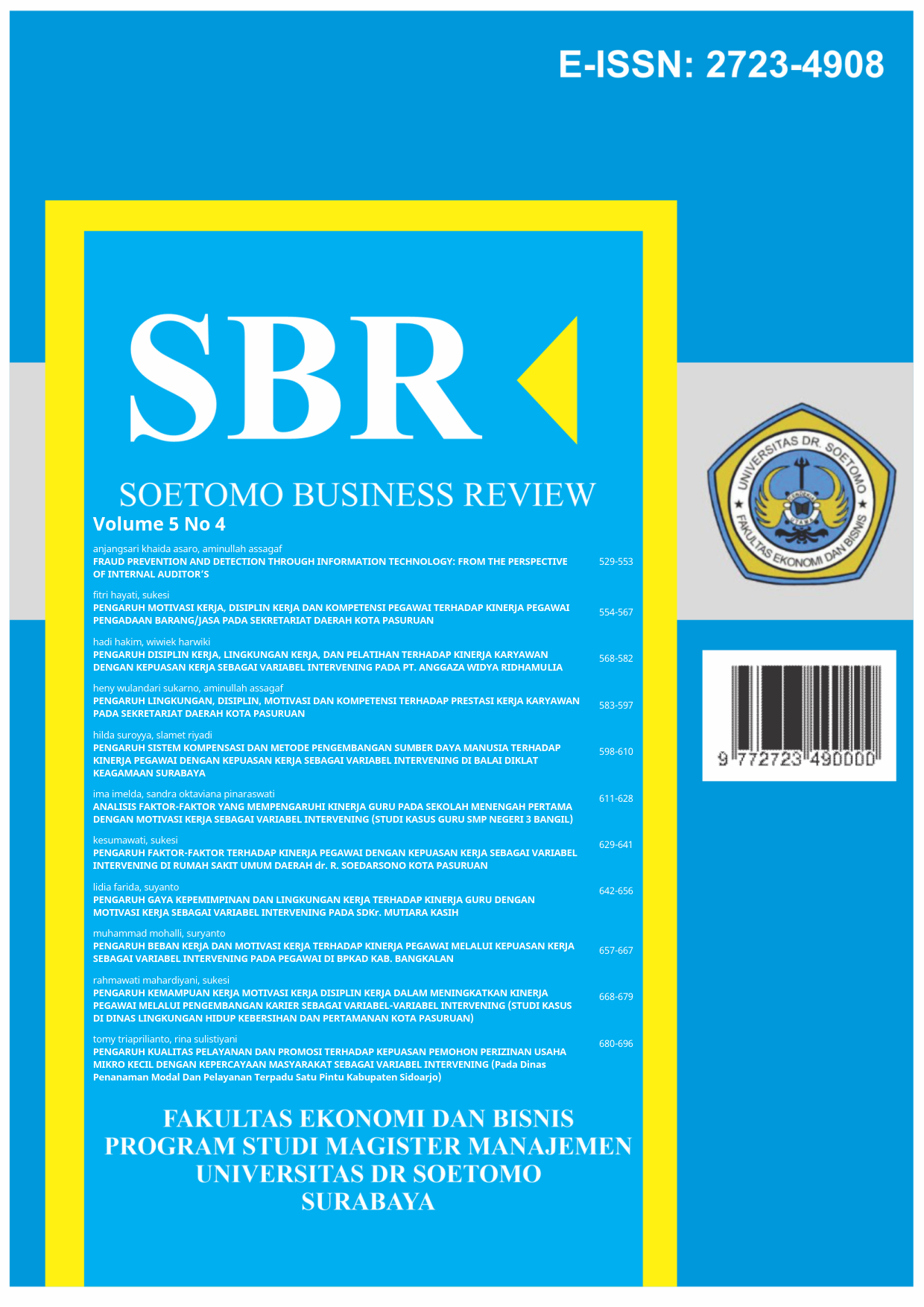FRAUD PREVENTION AND DETECTION THROUGH INFORMATION TECHNOLOGY: FROM THE PERSPECTIVE OF INTERNAL AUDITOR’S
 Abstract views: 31
,
Abstract views: 31
,
 pdf downloads: 22
pdf downloads: 22
Abstract
This study aims to explore internal auditors' perceptions regarding the prevention and detection of fraud through the use of the technology information. A literature review was conducted to understand the views of internal auditors on the use of information technology (IT) to prevent and detect fraudulent acts within the organization. The research method used is a qualitative approach by conducting in-depth questionnaires on several practitioners who are experienced in the field of auditing and internal control. Data was obtained through questionnaires distributed to internal auditors working in Indonesia. Data analysis was performed using descriptive analysis.The results of this study with the existence of good monitoring instruments, such as standardized policies and procedures, transparent reporting systems, and the use of appropriate information technology, organizations can be more effective in monitoring and controlling activities that have the potential to give rise to fraud. In conclusion, internal auditors view IT as an essential tool in fraud prevention and detection. However, a deeper understanding of IT capabilities is needed to deal with increasingly complex and sophisticated fraud. Therefore, companies need to strengthen their internal control systems by considering the advantages and disadvantages of IT in fraud prevention and detection.
References
Information Technology Application National Seminar.
Binus University. (2020). Types of Fraud – Business Creation. BINUS Higher Education. https://bbs.binus.ac.id/business-creation/2020/10/tipe-tipe-fraud/.
Coal, ED, & Si, M. (2020). Application of Forensic Accounting And Investigative Audit to Detecting Fraud. Journal of the Medan Juripol Polytechnic Institute of Ganesha , 3 (2).
Choirunnisa, R., & Rufaedah, Y. (2022). The Effect of Auditor Competence and Utilization of Information Technology on Fraud Detection. Journal of Accounting Trisakti , 9 (1).
Dimuk, M., Jatiningrum, C., & Gumanti, M. (2022). Detecting Fraud Factors in Financial Statements with the Audit Committee as Moderator. eCo-Fin, 4 (3), 1–9. https://doi.org/10.32877/ef.v4i1.454.
Deloitte. (2012). Fraud Analytics The three-minute guide. Deloitte Development LLC .
Hiererra, SE, & Sarayar, MOI (2014). Continuous Audit: Information Technology-Based Implementation and Control in Carrying out a More Effective and Efficient Audit Function. ComTech , 5 (2).
Kurniawan, Y. (2012). Scientific Periodical Accounting Students. Scientific Periodic Student Accounting, 1 (2).
Marciano, B., Syam, A., Suyanto, & Ahmar, N. (2021). Whistleblowing System And Fraud Prevention: A Literature Review. Indonesian Journal of Sustainable Accounting, 4 (3).
Maurer, R. (2013, Nov. 4). Fight Fraud with Employee Awareness. SRM Online. https://www.shrm.org/ResourcesAndTools/hr-topics/risk-management/Pages/Fight- Fraud-Employee-Awareness.aspx.
Mufidah. (2017). The Effect of Internal Inventory Control and Accounting Information Systems on Fraud Prevention Efforts in Inventory Management at PT Mitra Jambi Pratama. Batanghari University Scientific Journal, Jambi , 17 (3).
Mohamadi, RF (2022, December 22). What is Bank Reconciliation? Here's an example and procedure. Mekari Journal. https://www.jurnal.id/id/blog/apa-itu-fungsi- pengertian-rekonsiliasi-bank-Dari-berikut/.
Petraşcu, D., & Tieanu, A. (2014). The Role of Internal Audit in Fraud Prevention and Detection. ProcediaEconomics and Finance, 16, 489–497. https://doi.org/10.1016/s2212-5671(14)00829-6
Priantara, D. (2013). Fraud auditing & investigation (1 ed.). Media Discourse Partners. https://opac.perpusnas.go.id/DetailOpac.aspx?id=993361.
Rini, WAS, & Suwardi, E. (2021). The Role of the Code of Ethics in the Prevention of Fraud in Auditors within the Audit Board (Study at Bpk Ri Representative of East Java). Master of Accounting, Faculty of Economics and Business, Gadjah Mada University, Yogyakarta.
Suryani, F. H. (2013). The Influence of Audit Structure, Organizational Commitment, Role Conflict, and the Effectiveness of Accounting Information System Technology on Auditor Performance.
Syahputra, BE, & Afnan, A. (2020). Fraud Detection: The Role of Big Data and Forensic Auditing. Journal of ASET (Research Accounting), 12 (2), 301–316. https://doi.org/10.17509/jaset.v12i2.28939.
Utami, TL (2021). Analysis Of The Influence Of Independence, Professionalism, Anti- Fraud Awareness, And The Integrity Of Internal Auditors On The Prevention Of Fraud In Rural Banks.
Utami, L., Handajani, L., & Hermanto, H. (2019). The Effectiveness of the Audit Committee and Internal Audit on Fraud Cases with Whistleblowing System as a Moderating Variable. E-Jurnal Akuntansi, 1570.
https://doi.org/10.24843/eja.2019.v26.i02.p27
Widianingsih, R., Maghfiroh, S., Sunarmo, A., Economics, F., Business, D., & Soedirman, UJ (2018). The Effect of Information Technology and Accounting Reporting on Fraud Prevention. XVII (2), 110–123. http://jurnalnasional.ump.ac.id/index.php/kompartemen/.
Yulistianingsih, A. R. D., Hadi, F., Nurhabiba, & Suhartono. (2020). The Role of Forensic Accountants In Overcoming Fraud and Corruption In Government Institutions. Islamic Accounting and Finance Review , 1 (2).




